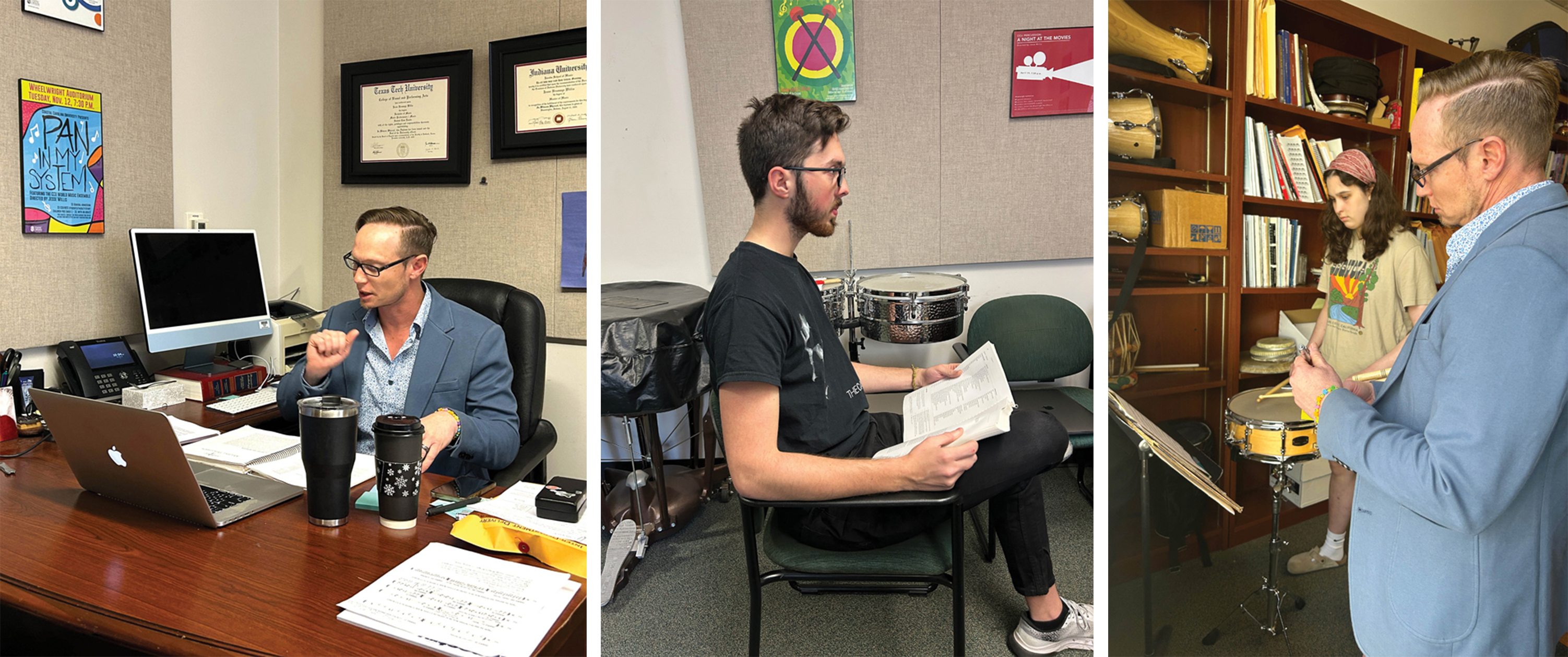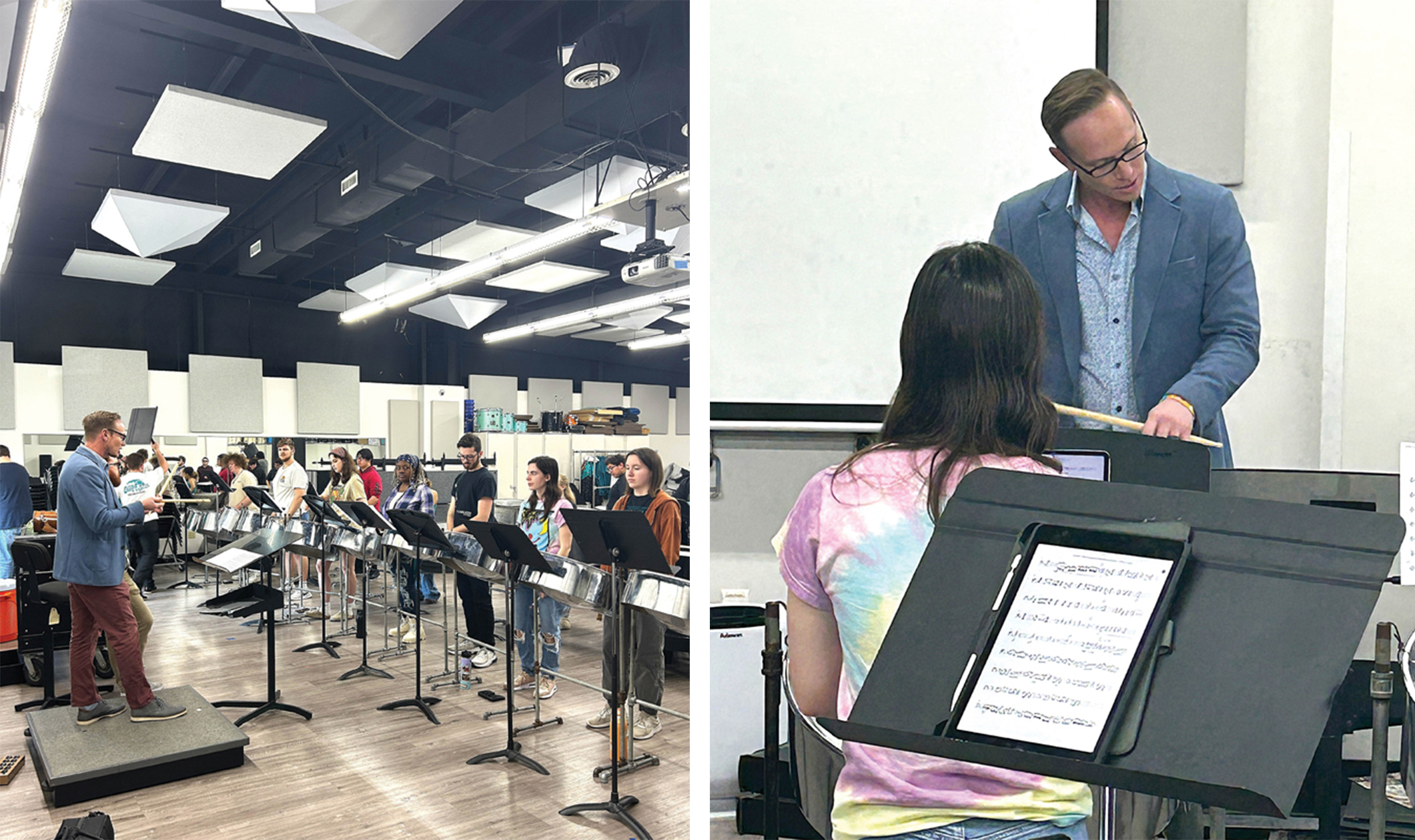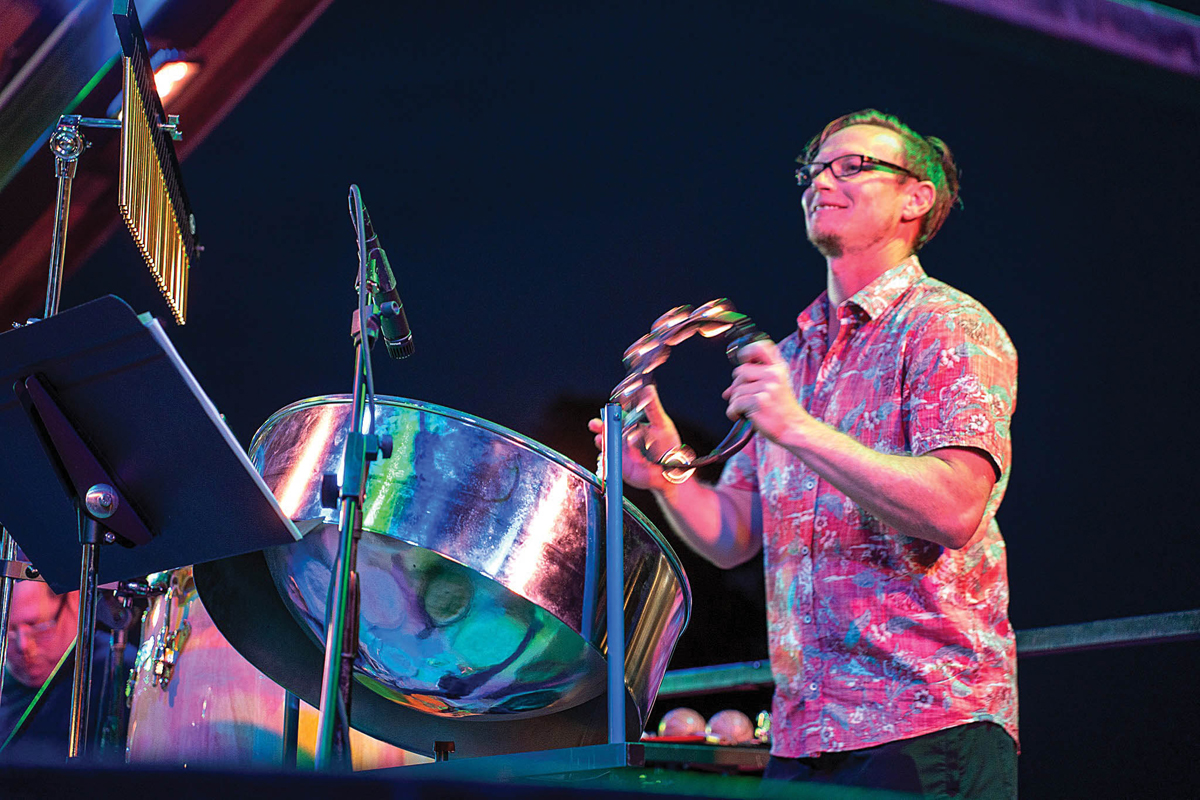A Day in the Life of Coastal Carolina University’s Dr. Jesse Willis

Who hasn’t experienced the joy of unabashed percussion? We all seem to automatically move when we hear a great marching band, or Afro-Caribbean rhythms. Maybe we start to groove hearing Latin genres such as salsa, samba, or bossa nova? Others find their feels with good ol’ head-banging rock ‘n’ roll. Or maybe as toddlers we first made our own music, starting with pots and pans? I used to get in trouble in middle school for banging on the desk with my hands. Percussion is often as important to a musical composition as is the melody; it drives the beat, creating a foundation, but it’s much more.
Percussion instruments are far more sophisticated than pots and pans we once banged on. They come in a dizzying array of styles and sizes with an equally vast number of functions. Some, like a standard drum set, are primarily for rhythm and time keeping. Others, like the marimba, xylophone, vibraphone, timpani, and (pan) steel drum, are melodic instruments providing melodies and chordal structure to a song, while giving it a percussive kick. Even the everyday piano is technically a percussion and string instrument hybrid. The cowbell is forever in a class of its own, thanks to Will Ferrell and Christopher Walken, and it’s become something of which we all apparently need more.
Dr. Jesse Willis instructs and guides 22 students enrolled at Coastal Carolina University studying percussion. The enrollment in the music department is around 100, with CCU’s total enrollment around 11,000. Willis is the Department Chair, Director of Percussion Studies and Professor primarily working out of CCU’s Edwards College of Humanities and Fine Arts facility.
Willis stays busy year-round, with requisite admin duties, budgeting, lessons, creating and leading concert events, evaluating staff, dealing with student issues, performing with staff and students, and he takes small groups to Trinidad for shows, workshops and educational purposes. For nearly 23 years Dr. Willis, 41, has been teaching kids and young adults percussion in one form or another, first at high schools in his home state of Texas and then Indiana, before accepting a position at CCU in 2010.
We wondered what Dr. Willis’ duties might look like from one hour to the next. He recently granted us the opportunity to spend the better part of the day with him.

9:12 a.m.
While his daily schedule varies, Dr. Willis generally starts each day early, at the gym, then on campus in his office. His desk is dwarfed by a nearby magnificent marimba worth nearly as much as a new car. Drums of every variety line the entryway and it’s obvious this is an active space. Shelves of percussion-oriented textbooks sit next to countless trophies and awards acknowledging a lifetime in the percussive arts. Willis holds a Bachelor of Music, Bachelor of Music Education and a Doctor of Music from Texas Tech in addition to a Master of Music from Indiana University. His most prized wall adornments, however, are not the hanging sheepskins, but the colorful drawings of “Daddy,” from both his young daughters. Willis’ Wife, Candice, is also a CCU employee working in Human Resources. The couple live in the Socastee area.
9:15 a.m.
Dr. Willis’ first student arrives for a private lesson. He typically gives four to five private lessons per week. David Robinson, 21, is from Mount Pleasant and is a senior music performance major studying multi-percussion in this lesson. His goal is to become an educator at the high school and/or collegiate level once he gets his masters and doctorate degrees. They look at the previous week’s homework (notational systems) and Willis quizzes him on the important bits.
Later another student, Julia Graham, from Spartanburg, stands at a snare drum and reads the complicated notations translating the printed music into rhythmic, crisp beats. She’s not the only woman in the program; nearly 30-percent of the percussion students are female. Graham and Ameilia Bonner are two of the young women studying percussion who recently visited Austria as part of a school-led music history trip. Bonner has been seen around town playing solo steel drum shows at area restaurants, and the occasional sit-in with area bands. After they finish their lessons, Dr. Willis and I have a few minutes for a deeper dive into the program and its amazing diversity.
“The majority of students that come to us hope to teach,” he explains. “Yes, there are performance opportunities for graduates—Myrtle Beach is a prime example—Long Bay Symphony, where I perform, plus the theaters [Carolina Opry, Alabama Theatre, Legends in Concert and others], local and regional bands—they all can provide fulltime salaried or part-time positions for a variety of musicians and singers.”
Not every student is headed for a teaching career, however. CCU holds its own ground against the Berkely’s of the world and other for-profit institutions focusing on commercial music. Many graduates of the music programs offered at CCU are still here in the Myrtle Beach area performing and working in production capacities. The diversity of programs offered at CCU can plot a course toward education, composition, music production, recording in-studio work, and, of course, performance. Even Dr. Willis finds time for this.
“I started here [at CCU], when I was 26,” says Willis. “In fact, Steve Bailey hired me.” Myrtle Beach resident bass guitar phenom Steve Bailey is widely known in international music circles, having performed and recorded with many of the world’s preeminent musicians. He was first a Professor of Music, later an Artist-In-Residence and faculty at the Bass Institute of America. He’s currently the Bass Department Chair at Berklee School of Music in Boston.
“At 26, I was just a couple of years older than many of my students,” continues Willis. “When I originally saw the job posting I jumped at the opportunity. I had been thinking about more performance-based careers—theatrical work like for Cirque du Soleil, or Broadway shows like The Lion King, very percussion oriented. I was always drawn to the unusual. For a long time, I dreamed of working with Stomp, or The Blue Man Group, but teaching and guiding young students is very fulfilling and a great opportunity.” And steady, stable work, unlike that in the fickle world of entertainment.
Willis makes time to perform whenever possible. He’s a percussionist with the Long Bay Symphony, performs with his students and faculty throughout the year on the CCU campus, and performs with students around the Grand Strand. Willis also performs on percussion and the steel drum with the Pour Buoys, a Trop Rock tribute band (shameless plug from the author, also in the group) playing lots of Jimmy Buffett and other Caribbean inspired music, usually about margaritas, sunsets and hammocks. Willis is an active member in WTF, a jazz quartet made up of faculty members.

10 a.m.
A candidate for a faculty position in the music department, Dr. Ellie Martin, is at Edwards this morning interviewing for a job. Dr. Willis and other music department faculty meet with her privately where she must audition.
Apparently, recitals are not just for students, but also for those wishing to be employed as music educators.
11 a.m.
Part one of Dr. Martin's evaluation is over with more to come in the afternoon. For now, there’s more paperwork (via a computer), student evaluations and emails that have piled up in Willis’ in-box, demanding his attention before lunch.
11:50 a.m.
Lunch this day is at one of the many local eateries near the CCU campus. He’s especially fond of Speedy Gamboa Mexican, an authentic Latin eatery. He’ll have only 30-minutes today as he’s due at the Coastal Band Hall, adjacent to the marching band practice field across U.S. 501. Here he’ll rehearse with CCU’s steel drum ensemble, CalypSamba, for an upcoming concert.
1 p.m.
At the off-campus Coastal Band Hall, Willis and two additional percussion instructors meet with the World Percussion class, steel drum and percussion students in a rehearsal for a late Spring concert. The ensemble rehearses twice a week. Many of these students travel to Trinidad to take part in workshops and visit the birthplace of the steel drum. Willis leads the group there once every two years.
The diversity of the ensemble showcases the broad appeal of these instruments. Freshmen to seniors, men and women, black, white and a mix of other minorities all take their places at steel drums that each have a specific function. The largest of the steel drums handle the low notes, a drummer behind a standard drum kit adds his important part, smaller steel drums handle the higher notes, a percussionist is stationed behind congas and other percussion instruments. Together they make beautiful music.
The Coastal Band Hall sits across U.S. 501 from the main campus next to an active train track and cement mill, something Willis says can be problematic.
“We are probably 25–50 students shy of being at our max capacity as it stands now. In many ways we’re already there,” he says while leafing through sheet music for the day’s rehearsal. “Our facilities are [challenged]. We are in desperate, dire need of upgrades in the number of facilities and their quality. There are hassles for the students and faculty, and anyone taking a tour would likely agree that our department has the most urgent needs at the university. I am convinced that with the right capital improvements, we could double our size to over 200 music majors because of the uniqueness of what we offer here and the talent of the faculty.”
Though Willis is a proficient musician on a variety of instruments, it seems there’s a special place in his heart for the steel drum. Volumes could be (and have been) written on the history of the instrument, also called a Steel Pan, or just “Pan.” Starting with its percussive roots in Africa, to the modern version developed in the 1930s. Just off the coast of Venezuela, local Trinidadians repurposed discarded 55-gallon oil drums, pounded them into submission, and the modern steel drum was born.
The unique sound, which rose to prominence in the extreme south Caribbean Sea, has become ubiquitous with nearly all Caribbean music thanks to songs from Calypso artists the Mighty Sparrow and Lord Kitchener. Trop rockers, too, have found good use of the pan. Jimmy Buffett’s “Margaritaville” features a steel drum solo and the pan is a constant in most of his music. Jazz and pop music have regularly featured the Pan, too. “Morning Dance,” a classic smooth jazz tune from Spyro Gyra hit the charts in 1979 becoming an international hit. British band UB40 scored a massive 1983 reggae-inspired hit, “Red Red Wine,” written by Neil Diamond in 1975 featuring the Pan. Even The Cantina Band in the Star Wars movie franchise features a pan solo, Sci-Fi style.
1:40 p.m.
The South Carolina Festival of Steel, recently staged as an all-day event at CCU, celebrated Caribbean music and culture with live performances of Calypso, Soca, Latin jazz, and popular tunes, featuring talented high school and middle school steel bands from across the state. The festival wrapped up with a special performance by CCU’s CalypSamba, and guest artist Amrit Samaroo from Trinidad.
The ensemble is working on a Bruno Mars cover, “Grenade,” arranged by Samaroo. They’ve worked and re-worked a complicated section for 30 minutes. Willis hands the reins over to another instructor so he can head back to campus for a continued faculty audition.

2 p.m.
At a 150-seat recital hall in the Edwards building Willis hustles to set up a drum kit where he and fellow music faculty perform as part of showcase open to all students and faculty. The teaching candidate, Dr. Martin, will sing a few standard jazz tunes and an original or two as a part of her audition.
There’s a smattering of students and faculty listening and Martin seems relaxed and sure of herself. (Just before press time Willis informed me that she got the gig.) Dr. Willis and the band breeze through her repertoire. At the end of the recital, Willis moves his drums back to his office. A student will arrive soon for a private lesson.
Marching to the Beat of a Different Drummer
Though he’s no longer involved in the day-to-day of The Spirit of the Chanticleer Marching Band, there was time when he was, and many of his students perform with them on the field for CCU football games.
I was heavily involved [with the marching band] the first 10 years I was here,” he recalls. Willis still attends most CCU football games with his colleagues, the Assistant Director of Marching Production Dr. Greg Tsalikis, and Director Dr. Garrett Griffin.
With its roots in the military, nothing excites the crowd quite like a well-rehearsed marching band. The oldest continually performing collegiate marching band in the U.S. is The Band of the Fighting Irish at the University of Notre Dame, which began at the school in 1845 and first performed at a Notre Dame football game in 1887.
More attention was brought to the world of marching bands with the 2002 film “Drumline.”
“The movies “Drumline” and “Drumline 2” had some inaccuracies as to notation and how that was portrayed,” says Willis, “but it was accurate to the HBCU (historically black colleges and universities) experience, and it brought a lot of attention to collegiate percussion. It showed the hard work it takes, mentally and physically, to be a part of a drumline at that level.”

3:15 p.m.
Dr. Willis and I prepare to part company, but not before I learn more about the influence of his students around the Grand Strand. CCU’s percussion students can be seen regularly not only on the gridiron, but in seasonal school performances, and other often free-to-attend community events. The annual Rioz Brazilian Steakhouse tour will commence again next spring with Dr. Willis and the student Samba Bateria percussion ensemble performing for guests of the area’s two Rioz restaurants.
As a part of CCU’s annual Cultural Arts Series, percussionists under Dr. Willis perform in a variety of shows each Fall and Spring, many of the shows are free to attend.
He takes his job seriously. His reputation is at stake when the ensemble performs. If they’re not up to par, it’s a reflection on him and the instructors under him. This is university-level music, not middle school or high school where “cute kids” are allowed to play poorly and given a hall pass. These students are expected to perform at a professional level, and they do.
“I’ve seen more people fired from gigs for having poor time and ability to stay with the band, than for playing a wrong note.”
What does Dr. Willis listen to in his scarce free time?
“I listen to a lot of Caribbean and Caribbean folk. Afro-Cuban. Latin jazz. Beyond that I like Tool, 3-11, and Soundgarden. If we’re being honest with ourselves, rhythm is the fundamental element of music.”
For more information on CCU’s Music Department shows visit: coastal.edu/culturalarts